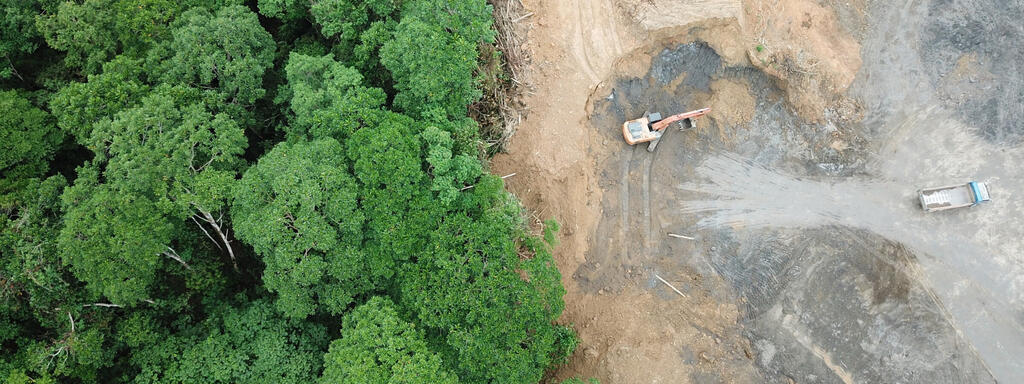
“Bleakest warning yet”: UN climate report
A major UN climate report was published last week, painting the direst picture yet of the impacts of climate breakdown. With the UN Secretary-General calling it “an atlas of human suffering and a damning indictment of failed climate leadership”, the report reiterates the human-induced nature of climate change. It also stresses that to avoid mounting loss of life, biodiversity and infrastructure, the world needs to undertake ambitious, accelerated action to adapt to climate change, while at the same time making rapid, deep cuts in greenhouse gas emissions.

The report assesses the impacts of climate change, looking at ecosystems, biodiversity, and human communities at global and regional levels. It also reviews vulnerabilities and the capacities and limits of the natural world and human societies to adapt to climate change.
It is the second of six instalments of the Sixth Assessment Report by the Intergovernmental Panel on Climate Change (IPCC), the UN body that provides governments and policymakers with scientific assessments on climate change. The first instalment, published last August, focused on the physical science basis of the climate crisis. It also provided a dire warning about the worsening climate crisis, with the UN Secretary-General calling it a “code red for humanity”.
HUMANITY TO BLAME
This report, like the first instalment, does not reiterate the findings of other IPCC reports in recent years, which explicitly stated that population growth was one of the most important drivers of increases in CO2 emissions from fossil fuel combustion, and that potential high population growth was a key impediment to hitting the critical target of limiting global warming to 1.5°C above pre-industrial levels. However, within its remit of reporting on climate change impacts, adaptation and vulnerability, it does clearly state that blame for the climate crisis lies squarely with humans:
“Human-induced climate change, including more frequent and intense extreme events, has caused widespread adverse impacts and related losses and damages to nature and people, beyond natural climate variability.”
“Widespread, pervasive impacts to ecosystems, people, settlements, and infrastructure have resulted from observed increases in the frequency and intensity of climate and weather extremes, including hot extremes on land and in the ocean, heavy precipitation events, drought and fire weather. Increasingly since [the Fifth Assessment Report] AR5, these observed impacts have been attributed to human-induced climate change particularly through increased frequency and severity of extreme events.”
The report highlights that even at current levels, global warming due to human activity threatens to render many areas unliveable. If temperatures rise by more than 1.5°C above pre-industrial levels, as we are currently on track for, this would result in some irreversible impacts, such as catastrophic melting of ice caps and glaciers.
VANISHING CARBON SINKS
In its assessment of the impacts of climate change, the report states that key ecosystems are losing their ability to absorb CO2, turning them from carbon stores into carbon emitters.
“Similar to tropical peatlands, given projected human population growth and socio-economic changes, the continued conversion of forests and savannas into agricultural or pasture systems very likely poses a significant risk of rapid carbon loss which will amplify climate change induced risks substantially.”
Due to the ability of trees to absorb CO2, forest conservation and restoration have been identified as critical in meeting climate targets. However, deforestation and forest degradation continue to take place at alarming rates, with the area of primary forest worldwide having decreased by over 80 million hectares since 1990. While the construction of infrastructure and the expansion of urban areas contribute significantly to deforestation and forest degradation, and the associated loss of forest biodiversity, agricultural expansion continues to be the main driver. This is, in turn, driven by the need to feed ever more people.

CLIMATE VULNERABILITY AND POPULATION
In its assessment of vulnerability and the exposure of ecosystems and people to climate change impacts, the report states that approximately 3.3 to 3.6 billion people live in contexts that are highly vulnerable to climate change. These people generally live in low- to middle-income countries and regions that also have high population growth. The report continues:
“Since [the Fifth Assessment Report] AR5 there is increasing evidence that degradation and destruction of ecosystems by humans increases the vulnerability of people. Unsustainable land-use and land cover change, unsustainable use of natural resources, deforestation, loss of biodiversity, pollution, and their interactions, adversely affect the capacities of ecosystems, societies, communities and individuals to adapt to climate change.”
Population growth is a key driver of all these climate change-causing factors. In addition, as the report makes clear, it also interacts with adverse climate change impacts on people, particularly the most vulnerable, and magnifies the climate risks.
EMPOWERING SOLUTIONS
The report states that Climate Resilient Development is already challenging at current warming levels. It will become more limited if global warming exceeds 1.5°C. In some regions, it will be impossible if warming exceeds 2°C. This finding underlines the urgency for climate action, focused on equity and justice, to keep warming to below 1.5°C, and to help the most vulnerable adapt to and build resilience against increasingly dangerous climate change impacts.
Given this urgency, the immediate climate change priority should be the rapid implementation of solutions that will be maximally effective over the coming decade. However, Population Matters also urges acknowledgement of the fact that slowing population growth through ethical, voluntary means will help to reduce emissions, protect carbon sinks and maximise the effectiveness of all other solutions over the medium to longer term.
The value of population action to address climate change has been quantified by the world-leading study of available climate change solutions, Project Drawdown. In 2020, it analysed 82 practical policy options for reducing greenhouse gas emissions, ranging from plant-based diets to refrigerant management. It found that, even when factoring in the far lower climate emissions of countries in the Global South, empowering women and girls through universal access to education and safe, modern family planning would save 85 gigatonnes of emissions by 2050. This makes these ethical population actions the second most effective solution in limiting warming to 2°C, and fifth most effective in limiting warming to 1.5°C, by 2100.
In January this year, Project Drawdown published a policy briefing in which it recommended that governments, organisations and funding bodies recognise the importance of universal education and family planning as a climate solution.



